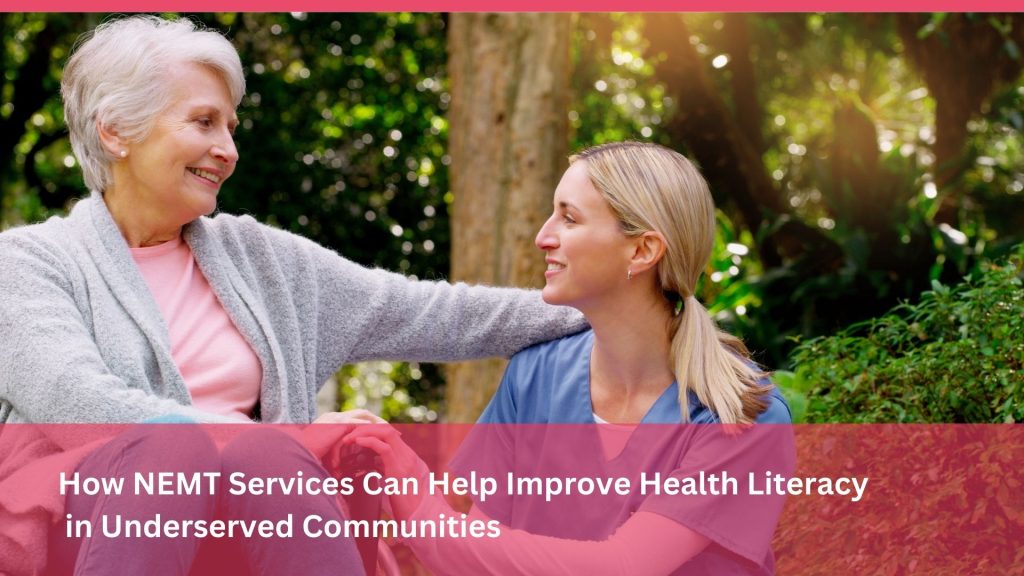New at Safr Care
How NEMT Services Can Help Improve Health Literacy in Underserved Communities

How NEMT Services Can Help Improve Health Literacy in Underserved Communities
Health literacy is a crucial factor in ensuring effective healthcare outcomes. In underserved communities, where access to healthcare information and resources can be limited, improving health literacy is particularly challenging. Non-Emergency Medical Transportation (NEMT) services not only facilitate access to medical care but also play a significant role in enhancing health literacy by bridging information gaps and supporting education initiatives. This article explores how NEMT services contribute to raising health literacy levels in these communities, ultimately leading to better health outcomes and reduced healthcare disparities.
1. Facilitating Access to Healthcare Services
For many in underserved areas, simply getting to a healthcare provider can be a significant barrier. NEMT services eliminate this obstacle by:
- Providing Reliable Transportation: Ensuring that residents can attend appointments, health education sessions, and wellness programs without transportation being a barrier.
- Increasing Appointment Adherence: Reducing missed appointments helps maintain continuity of care, crucial for effective treatment and health education.
- Enabling Regular Health Screenings: Regular access to healthcare services allows for consistent health monitoring and early detection of conditions, facilitating timely medical advice and education.
These services help individuals consistently engage with healthcare providers, enhancing their understanding of health conditions and the healthcare system.
2. Supporting Health Education Initiatives
NEMT can be an active participant in health education by transporting individuals to various health education programs and community health initiatives. This support includes:
- Access to Educational Programs: Transport to workshops and seminars where individuals can learn about nutrition, chronic disease management, and preventive healthcare.
- Participation in Community Health Events: Providing rides to health fairs, vaccination drives, and screening events that also serve as educational opportunities.
- Collaboration with Health Organizations: NEMT providers can partner with local health departments and non-profits to promote and facilitate attendance at health education activities.
By ensuring that community members can access these resources, NEMT services help enhance the overall health literacy of the community.
3. Bridging Language and Cultural Barriers
In communities with diverse populations, language and cultural differences can hinder health literacy. NEMT services can help bridge these gaps by:
- Providing Multilingual Services: Employing drivers who speak multiple languages or offering materials in various languages can help in communicating health information effectively.
- Understanding Cultural Sensitivities: Drivers and staff trained in cultural competencies can better communicate and interact with patients from diverse backgrounds, making them feel more comfortable and open to receiving health information.
Such culturally aware services encourage better communication and understanding between healthcare providers and patients, enhancing health literacy.
4. Reducing Economic Barriers
Economic challenges often prevent individuals in underserved communities from seeking medical advice or participating in health education. NEMT addresses this by:
- Minimizing Travel Costs: Free or low-cost transportation removes the financial burden of getting to healthcare facilities, which can be a significant barrier to accessing educational resources.
- Supporting Low-Income Families: By reducing the cost and stress associated with transportation, families can better utilize their resources towards maintaining and improving health.
This financial support is essential for allowing continuous health education and improving understanding of healthcare practices.
Conclusion
NEMT services are more than just a means of transportation; they are a vital tool in the effort to enhance health literacy in underserved communities. By providing reliable and culturally sensitive transportation to healthcare and educational services, NEMT helps empower individuals with the knowledge to make informed health decisions, fostering a healthier community overall. As such, the integration of NEMT into public health strategies is essential for addressing healthcare disparities and improving community health outcomes.
